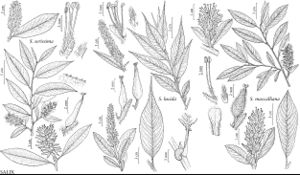Difference between revisions of "Salix exigua"
N. Amer. Sylv. 1: 75. 1842.
FNA>Volume Importer |
FNA>Volume Importer |
||
| Line 61: | Line 61: | ||
|publication year=1842 | |publication year=1842 | ||
|special status= | |special status= | ||
| − | |source xml=https://jpend@bitbucket.org/aafc-mbb/fna-data-curation.git/src/ | + | |source xml=https://jpend@bitbucket.org/aafc-mbb/fna-data-curation.git/src/f6b125a955440c0872999024f038d74684f65921/coarse_grained_fna_xml/V7/V7_46.xml |
|genus=Salix | |genus=Salix | ||
|subgenus=Salix subg. Longifoliae | |subgenus=Salix subg. Longifoliae | ||
Revision as of 21:22, 24 September 2019
Shrubs or trees, 0.5–5(–17) m. Stems: branches gray-brown, red-brown, or yellow-brown, villous, or tomentose to glabrescent; branchlets yellowish, yellow-brown, or red-brown, pubescent or puberulent, tomentose, short- or long-silky villous. Leaves: stipules absent or rudimentary on early ones, foliaceous or rudimentary on late ones; petiole 1–5(–10) mm, pubescent or puberulent, villous, or short-silky adaxially; largest medial blade (sometimes hypostomatous), linear or lorate, (glands marginal), 30–136–143 × 2–14 mm, 6.5–28(–37.5) times as long as wide, base cuneate, margins slightly revolute, entire or remotely spinulose-serrulate, apex acuminate or acute, abaxial surface glaucous (sometimes obscured by hairs), densely long-silky, villous or pilose to glabrescent, hairs appressed or spreading, straight or wavy, adaxial slightly glossy, sparsely or densely long-silky to glabrescent; proximal blade margins entire; juvenile blade yellowish green, densely long-silky-villous abaxially. Catkins: staminate 7–54 × 2–10 mm, flowering branchlet 1.5–56 mm; pistillate loosely to densely flowered, slender or stout, 14.5–70 × 3–12 mm, flowering branchlet 2–55 mm; floral bract 1.2–2.6 mm, apex acute, convex, or rounded, entire or erose, hairs wavy, straight, or crinkled, abaxially hairy throughout or proximally, or glabrate. Staminate flowers: abaxial and adaxial nectaries present and distinct; filaments hairy on proximal 1/2; anthers (sometimes reddish turning yellow). Pistillate flowers: adaxial nectary oblong, ovate, or flask-shaped, relative adaxial nectary/stipe length variable even within same catkin; stipe 0–0.9 mm; ovary obclavate or pyriform, glabrous, pilose, or villous, or sometimes beak hairy, beak bulged below or abruptly tapering to styles; ovules 12–30 per ovary; styles (sometimes distinct), 0–0.5 mm; stigmas flat, abaxially non-papillate with rounded tip, or 2 plump lobes, 0.1–0.5 mm. Capsules 4–8 mm. 2n = 38.
Distribution

w North America.
Discussion
Varieties 2 (2 in the flora).
Selected References
None.
Lower Taxa
Key
| 1 | Branchlets densely short-silky-tomentose or short-silky-villous; juvenile blades densely long-silky abaxially, hairs usually appressed, sometimes a few spreading; stipes 0.2-0.9 mm; styles connate, 0-0.2 mm; ovaries usually glabrous, sometimes beak hairy; stigmas flat, abaxially non-papillate with rounded tip, or 2 plump lobes. | Salix exigua var. exigua |
| 1 | Branchlets pubescent or densely long-silky-villous; juvenile blades densely long-silky-villous abaxially, hairs spreading, appressed; stipes 0-0.2 mm; styles connate or ± distinct, 0.1-0.5 mm; ovaries pilose or villous to glabrescent; stigmas flat, abaxially non-papillate with pointed tip, or slenderly cylindrical. | Salix exigua var. hindsiana |
